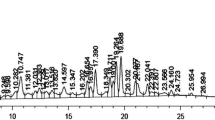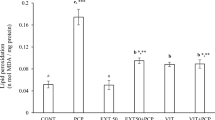Abstract
The hepatoprotective potential of a protein-enriched fraction (PEF) isolated from the maggots of housefly (Musca domestica) was evaluated in rats against carbon tetrachloride (CCl4)-induced acute hepatic damage. Activities of serum aspartate aminotransferase and alanine aminotransferase increased by 4- and 13-fold induced by CCl4, were significantly inhibited by pretreatment with 50, 100 and 200 mg PEF/kg. The formation of malondialdehyde was also significantly decreased in PEF-treated group compared with CCl4-treated group. The treatments with PEF also elevated total protein levels significantly. These results were further supplemented by histopathological examination of liver sections. Hyperplasia of kupffer cells was observed after treatment with PEF (100 and 200 mg/kg). We conclude that PEF is effective in this model of liver damage.

Similar content being viewed by others
References
Arii S, Imamura M (2000) Physiological role of sinusoidal endothelial cells and Kupffer cells and their implication in the pathogenesis of liver injury. J Hepatobiliary Pancreat Surg 7:40–48
Bhandarkar MR, Khan A (2004) Antihepatotoxic effect of Nymphaea stellata willd., against carbon tetrachloride-induced hepatic damage in albino rats. J Ethnopharmacol 91:61–64
Jeon TI, Hwang SG, Lim BO, Park DK (2003) Extracts of Phellinus linteus grown on germinated brown rice suppress liver damage induced by carbon tetrachloride in rats. Biotechnol Lett 25:2093–2096
Lee KJ, Woo ER, Choi CY, Shin DW, Lee DG, You HJ, Jeong HG (2004) Protective effect of acteoside on carbon tetrachloride-induced hepatotoxicity. Life Sci 74:1051–1064
Li SZ (1981) Compendium of Materia Medica. People’s Medical Press, Beijing, China, pp 2289–2290
Liu JY, Chen CC, Wang WH, Hsu JD, Yang MY, Wang CJ (2006) The protective effects of Hibiscus sabdariffa extract on CCl4-induced liver fibrosis in rats. Food Chem Toxicol 44:336–343
Ohkawa H, Ohishi N, Yagi K (1979) Assay for lipid peroxides in animal tissues by thiobarbituric acid reaction. Anal Biochem 95:351–358
Pagliara P, Carlà EC, Caforio S, Chionna A, Massa S, Abbro L, Dini L (2003) Kupffer cells promote lead nitrate-induced hepatocyte apoptosis via oxidative stress. Comp Hepatol 2(1):8
Sato Y, Yoneda M, Nakamura K, Makino I, Terano A (2003) Protective effect of central thyrotropin-releasing hormone on carbon tetrachloride-induced acute hepatocellular necrosis in rats. J Hepatol 39:47–54
Sherman RA, Hall MJ, Thomas S (2000) Medicinal maggots: an ancient remedy for some contemporary afflictions. Annu Rev Entomol 45:55–81
Tang X, Gao J, Wang Y, Fan YM, Xu LZ, Zhao XN, Xu Q, Qian ZM (2006) Effective protection of Terminalia catappa L. leaves from damage induced by carbon tetrachloride in liver mitochondria. J Nutr Biochem 17:177–182
Tietze F (1969) Enzymic method for quantitative determination of nanogram amounts of total and oxidized glutathione: applications to mammalian blood and other tissues. Anal Biochem 27:502–522
Wang FR, Huang W, Wang YL, Lei CL (2005) Proteins isolated from the larva of the housefly and their activities on scavenging the hydroxyl radical. Chinese Bull Entomol 42:546–549
Wills PJ, Asha VV (2006) Protective effect of Lygodium flexuosum (L.) Sw. extract against carbon tetrachloride-induced acute liver injury in rats. J Ethnopharmacol 108:320–326
Acknowledgments
We would like to thank Professor Shi-Qi Zhou (College of Animal Medicinal Science, Huazhong Agricultural University) and Wen-Xiang Yang (Hubei Provincial Center for Diseases Control and Prevention) for their technical assistance.
Author information
Authors and Affiliations
Corresponding author
Rights and permissions
About this article
Cite this article
Wang, FR., Ai, H., Chen, XM. et al. Hepatoprotective effect of a protein-enriched fraction from the maggots (Musca domestica) against CCl4-induced hepatic damage in rats. Biotechnol Lett 29, 853–858 (2007). https://doi.org/10.1007/s10529-007-9321-x
Received:
Revised:
Accepted:
Published:
Issue Date:
DOI: https://doi.org/10.1007/s10529-007-9321-x




